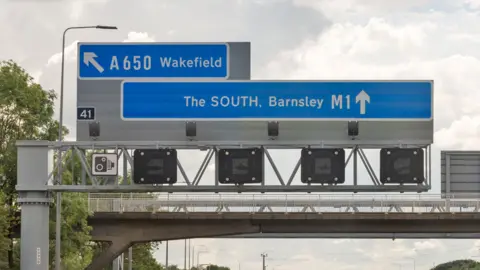Is social mobility really about school cash?
 Alamy
AlamyIf you took a list of the top 20 places in England where schools have the most funding, 18 of them would be in London.
And if you took another list, of the top 20 places with the highest level of social mobility, 17 of them would also be in London.
Is that a coincidence?
Head teachers in the Worth Less? campaign over school funding shortages say that if the government is serious about promoting social mobility in education, then it needs to look at how low funding seems to mirror low mobility.
West Somerset has the lowest place on the government's social mobility index - and is also one of the lowest-funded areas.
The Worth Less? campaign, which has brought together about 5,000 schools over the issue of fair funding, has produced an analysis showing that a secondary school in West Somerset would receive £2m less per year than a similar sized school in Westminster.
Westminster, in the top 10 for funding, is rated as giving its disadvantaged young people the highest chance of social mobility in the country.
And a key aspect of the success of London's schools has been that poorer youngsters, such as those eligible for free school meals, do much better in the capital than elsewhere.
Funding gaps
Of course, there are many other crosswinds in such a complex topic.
Schools in London get more funding because they have bigger challenges - extra costs because of their location and extra demands, such as high levels of deprivation and many pupils speaking English as a second language.
It has often been claimed that London has its own demographic microclimate, with many migrant families arriving with high ambitions for their children.
But head teachers argue that there's no escaping the overlap between social mobility and financial support. None of the lowest-funded 20 authorities makes it into the top 50 for social mobility.
And the top 10s for funding and social mobility are shuffling very similar packs.
Top 10 for funding
- Hackney
- Tower Hamlets
- Southwark
- Lambeth
- Islington
- Hammersmith and Fulham
- Camden
- Haringey
- Westminster
- Kensington and Chelsea
Top 10 for social mobility
- Westminster
- Kensington and Chelsea
- Tower Hamlets
- Wandsworth
- Hackney
- Redbridge
- Islington
- Hammersmith and Fulham
- Barnet
- Ealing
Jules White, a head teacher from West Sussex who has co-ordinated the Worth Less? school funding campaign, is calling for a much closer look at what the variation in funding really means for those outside the capital.
The funding gap between West Somerset and Westminster, for an individual school, is the equivalent of dozens of extra teaching staff, after-school clubs, university links, careers advice and support for pupils who are struggling.
And these are exactly the kinds of added extras that could improve social mobility.
Mr White, speaking at a Westminster Education Forum event on school funding, has broken down the figures to per-pupil spending.
 Getty Images
Getty ImagesBarnsley, near the bottom for social mobility, has £4,729 for each secondary pupil, while Hackney, in the top five for social mobility, receives £7,840.
How much could schools in Barnsley help their young people with an extra £1,000 per term for each of them? Or what more progress could be supported in other areas on the bottom rungs for funding, such as York, Leicestershire and West Sussex.
But it's not always such a neat match between funding and social mobility. Nottingham and Manchester are among areas that are relatively well-funded, but don't do particularly well on social mobility.
Tightrope act
The Westminster forum on funding heard warnings that the answer was not taking money from schools in the capital.
A chair of governors from a secondary school in Lambeth said that the changes proposed in the new national funding formula would leave them with a budget deficit heading towards £500,000, which could only be resolved by significant cuts in the teaching staff.
Valentine Mulholland, of the National Association of Head Teachers, said the funding squeeze had already meant the loss of jobs for teaching and support staff.
And a study from the National Foundation for Educational Research (NFER) suggested higher spending particularly benefited disadvantaged pupils.
 Getty Images
Getty ImagesNew Education Secretary Damian Hinds has made a priority of social mobility - but he will also have to make some big decisions about the pressure over school funding.
The Department for Education has consistently argued that there are record levels of funding - and the NFER's Ben Durbin agreed that by international standards, England's schools are relatively well-funded.
The political tightrope act for ministers is to push more cash to the less well-funded areas without damaging those schools performing well in better-funded places.
But the head teachers are arguing that funding and social mobility should no longer be seen as separate conversations.
